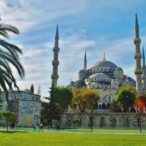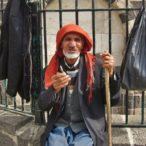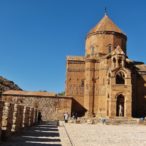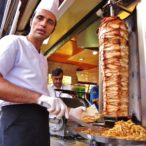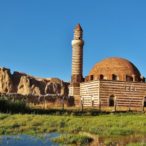Turkey
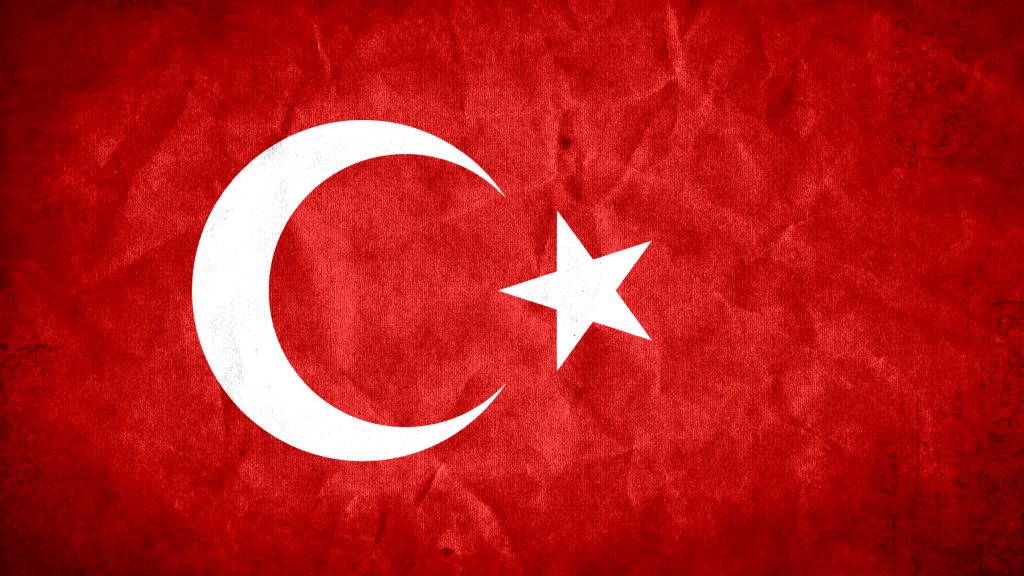
Official name: Republic of Turkey
Population: 80 427 000
Area: 783 562 km²
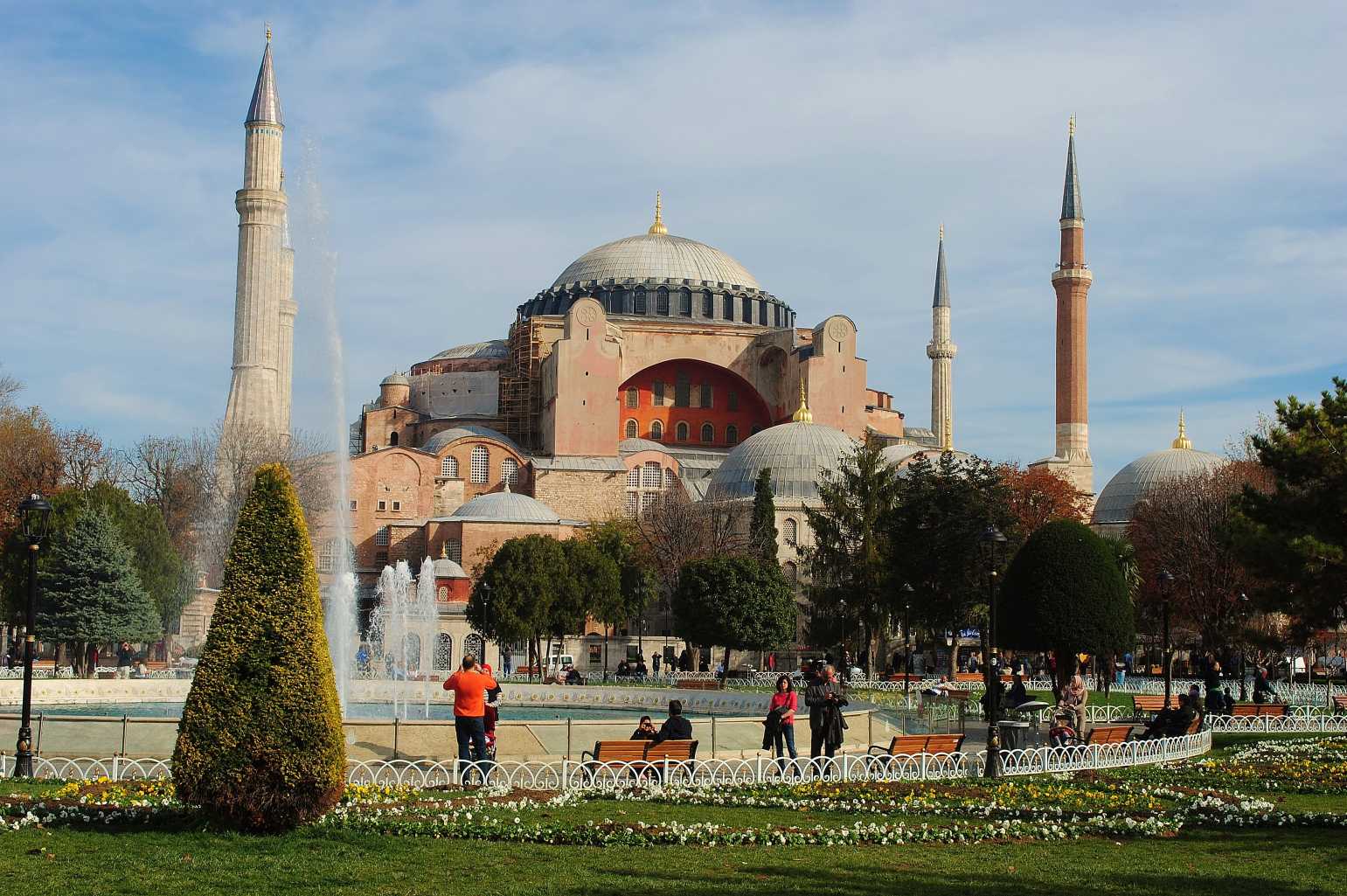
Gallery
The introduction of Turkey, tourist attractions of Turkey, Turkey – the present times, history of Turkey.
Introduction
To most tourists from Europe Turkey is viewed only through Istanbul, Antalya and the whole of the Mediterranean coast. On top of it cheap flights give average European tourists a feeling of closeness which is destructive and harmful to our European culture. Turkey is a country in Asia Minor, with only 3% of its territory in Europe and and this is only because Constantinople was conquered by the Turks and forcibly incorporated into its territory. Turkish people themselves come from Central Asia so from the territories of today’s Kazakhstan, Uzbekistan, Turkmenistan and even Mongolia but they moved to Western Asia in the sixth century, though the process was long and as a result cost millions of deaths from the hands of Muslim Ottomans. Therefore the people and the culture of Turkey have nothing to do with the European ethnicity and culture but with the Asian. In addition Turkey’s culture is based on Islam, on production of carpets, lanterns popular in the Sultan’s palace, production of Arabian sweets and many other interesting rituals typical for the Muslim world. even the way of drinking tea is similar to the one in Iran and that’s why it is different than the one in Europe. It is also very important to look at Turkey from the perspective of “to the west and to the east of Ankara”, because the standard of living and Muslim conservatism are very different from each other depending on the region.
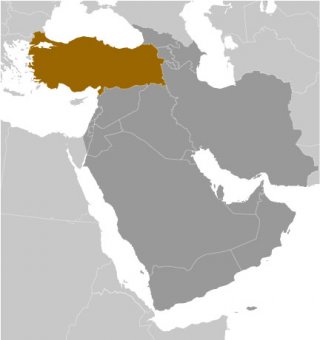
Globalists like to show Turkey on the map of Europe but in my opinion it is a harmful, anti-white and anti-Christian propaganda. Here we can see the location of Turkey in the right way.
Precisely because of all those differences Turkey is an interesting country for Europeans and I want to make it clear to my readers that Turkey is ethnically and culturally Asian and it fully deserves to be called Asian. Partly for that reason I am discussing Turkey on my website, which is titled “Exploring Asia.”
Tourist attractions of Turkey
Turkey has a lot of beautiful and valuable things that make that country very attractive to tourists and travellers. Turkey has 4 seas, mountains, beautiful lagoons, nice beaches, warm climate, rich crafts, interesting art and architecture left by the ancestors, good food and reasonable prices. Turkey is a country where one day you can swim in the sea with turtles, another day go skiing or live in a rock-cut temple and next day visit wonderful sights. I also think that even if Turkey didn’t have all those great attractions it would be still attractive to me because then I would at least have the pleasure of visiting Turkish bazaars, drinking Turkish tea and watching how they prepare Turkish coffee. I would enjoy looking at Turkish carpets and lanterns and I would observe millions of other original items and even fishermen on the bridges of Istanbul. All those things make Turkey a very attractive tourist destination, which requires time because it is a large country which forces travellers to go long distances and each region is different. In addition, Eastern Turkey is different from Western Turkey because it is mostly inhabited by a different nation, by the Kurds, who have their crafts, their customs and their own story to tell. Even the Turks themselves divide their country into “east and west of Ankara” and although Turkey has of course its highlights, in my opinion to a tourist from a European country everywhere is interesting.
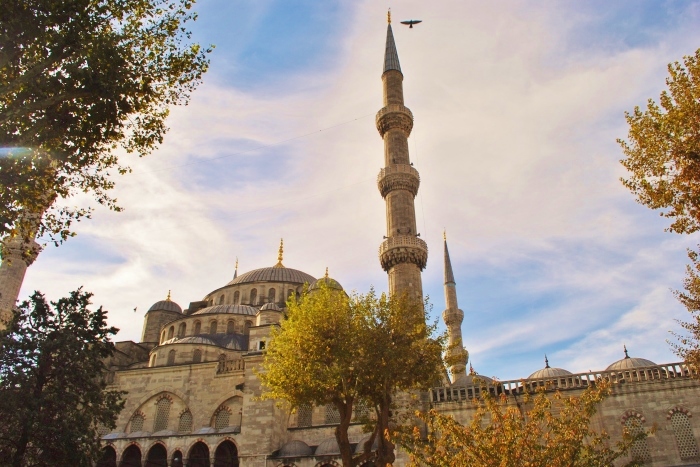
The Blue Mosque – Istanbul. Turkey.
I think that most travelers start their Turkish adventure in Istanbul. Istanbul is a city on the border of Europe and Asia which has such monuments as the huge Sultan Ahmet mosque (the blue mosque), the less known but attractive Sulemaniya mosque, Hagia Sofia which is a remnant of the Christian history of Constantinople, the Great Bazaar which in my opinion is an exceptionally good place for learning about the character of Turkey and the Top Kapi Palace with its panoramic views of Istanbul. There are also places like the Galata Tower or the Bosphorus cruise which I highly recommend. Istanbul is an important city for travellers because this is where they begin their Turkish adventure and contact with the Turkish culture and which they discover through traditional bazaars, Turkish tea, kebabs, posters with Kemal Ataturk and fishermen who don’t have any mercy to small Bosporus fish. Another very interesting city is Bursa, near the Marmara Sea, which is a well preserved remnant of the Ottoman Empire and where many of the monuments date from the 14th century. In Bursa there are ancient mosques and mausoleums, old bazaars where one can smell the spices and where of course travellers can bargain for a carpet with a glass of Turkish tea and delicious kebab. Bursa is about 150km from Istanbul. Another city is Izmir, lying on the Aegean Sea and Turkey’s capital Ankara with a must see Ataturk mausoleum. Each of those cities unfortunately has tiring traffic and modern buildings but there are also places of interest attractive to tourists.
Very popular is of course the Turkish Riviera on the Mediterranean Sea with its centre in Antalya, although there are other popular places such as: Alanya, Oludeniz, Fethiye, Kas, Dalaman and Kemer. All those towns are tourist ghettos for people with different sized wallets, where there are nice beaches and many different attractions, although I especially recommend the cruise on the blue lagoons. Near Fethiye, there is also the Lycian Way which is a beautiful mountain route with sea views and which is ranked very highly among the most scenic spots in Turkey. In that region there is also a mausoleum built into a rock which in its size reminds a small version of Petra. Another popular place is Cappadocia which I call a rock town. There are conical rocks transformed into living rooms and although those are the signature highlights of Cappadocia, the whole region is popular for its cycling tours, balloon flights, beautiful valleys and sights. (There is a similar place in Kandovan in Iran and in Goris in Armenia but Cappadocia has better tourist facilities).

Kebabs in Istanbul. Turkey
The two best preserved and very popular ruins are Pergamum and Ephesus. North of Izmir lies Pergamum and Asclepion, which have been ancient Greek cities since around the 5th century BC and where today there are characteristic Greek columns as well as Greek theathre and temples resembling those of the Acropolis. To the south of Izmir lies Ephesus which is a great Roman city built in the 10th century BC and which among many other things has a huge Roman theater with 25.000 seats, a library, a medical school and a temple dedicated to the goddess Artemis. On the way from Izmir to Antalya there is the most idyllic place in Turkey, which according to me is Pamukkale. Pamukkale is a spectacular, even dazzling place composed of white terraces located on a hill, which are filled with thermal water with limestone salt and which were formed by solidified limestone springs. The ruins of Hierapolis are also nearby.
I think that in the north of Turkey, near the Black Sea, the best place is the Orthodox monastery of Sumela built on a hillside but the whole region offers of course beautiful views. Another important place is Ani, which is a remnant of the Great Armenia and is today called the “city of thousand churches” – sadly ruined churches in fields overgrown with grass. Interestingly, despite the indisputable evidence to date, Turkey denied that it had murdered 1.5 million Armenian Christians. Also, how can Turks explain that Armenians no longer live in Ani? Did they decide to leave their capital behind to make space for Turks? From Ani there is a view of the biblical Ararat where Noah finished his cruise.

The Akdamar church on lake Van. Turkey.
There is still south-eastern Turkey, which is known as the unofficial “Turkish Kurdistan” – a region with strong military presence and major political problems but also a region which is attractive to tourists. In my opinion the tourist centre of south-eastern Turkey is lake Van with its main town, also Van and the Van castle. On lake Van, there is an Armenian church built in the 10th century called Akdamar. Today it is a beautiful place for history lovers who can see frescoes and bas-reliefs but it is also a good place to relax in the bosom of the nature. Nearby there is also Hosap castle built on the mountain by the Ottomans in the seventeenth century, and not far from Tatvan there is beautiful Nemrut Valley – a geopark with the second largest crater lake in the world. It is a nice place to rest, it has clean water and it’s surrounded by mountains where travellers can also see sheep shepherds and the rural life of Turkey.
I also recommend Ahlat with the tombs of Seljuks which are located a few kilometers from Nemrut. Another interesting place is Nemrut Dagi, which has huge stone heads on top of the mountains and which is about 2000 years old. I also admit that I liked the Kurdish city of Diyarbakir with its historic mosque, the bridge over the Tigris river and the fortified walls built by the Romans. About 30km from Batman there is also the historic Hasankeyf, a picturesque area by the river, surrounded by caves in the mountains.

Turkish bazaar. Istanbul. Turkey.
Turkey however, has a lot more interesting places and experiences beyond the worn-out trail. These include rarely visited islands, crazy hitchhiking, bars on the roads, observation of sheep shepherds on donkeys, military bases in eastern Turkey and the war like climate of the region, as well as carpets, spices, kebabs, bazaars, sweets and Turkish tea.
Turkey – the current times
Economy
Turkey has the 17th highest GDP in the world according to PPP, the 20 largest nominal GDP and it is a member of G-20. The CIA classifies Turkey as a developed country, although Turkey is often considered a newly industrialized country by economists and politicians. Merrill Lynch, the World Bank and The Economist describe Turkey as an emerging market economy. The World Bank classifies Turkey as a country with an average GDP per capita. The average remuneration for graduates in 2010 was $ 10.02 / h. The Turkish labor force participation rate of 56.1% is by far the smallest among OECD countries with an average rate of 74%. According to a survey by Forbes magazine Istanbul was the financial capital of Turkey in 2013 with a total of 37 billionaires, placing fifth in the international arena behind Moscow (84 billionaires), New York (62 billionaires), Hong Kong (43 billionaires) and London (43 billionaires).
The customs union between the EU and Turkey in 1995 has led to significant tariff liberalization and is one of the most important pillars of Turkey’s trade policy. Turkey’s exports in 2011 reached $ 143.5 billion, while in 2012 it was already $ 163 billion. Major export partners in 2012 were Germany with 8.6%, Iraq with 7.1%, Iran with 6.5%, United Kingdom with 5.7% and United Arab Emirates with 5.4%. The main import partners are in Russia: 11.3%, Germany 9%, China 9%, USA 6% and Italy 5.6%.
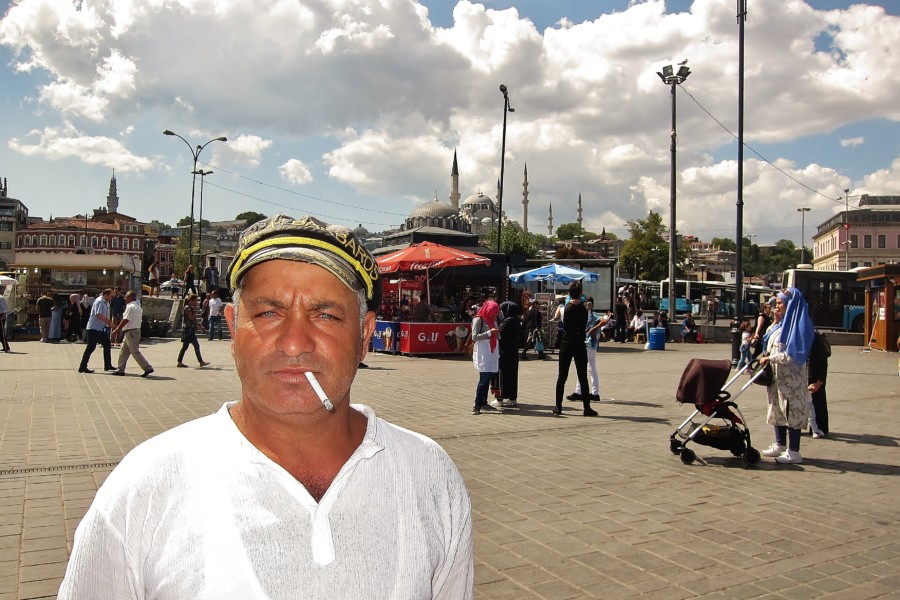
Turkish sailor in Istanbul. Turkey.
The key sectors of the Turkish economy are banking, construction, household appliances, electronics, textiles, petroleum refining, petrochemical products, food, mining, iron and steel and machinery. However, there are others such as defense, communication, tourism and transport. As far as the defense industry is concerned Turkey produces for example the American F16 for the Turkish army, but also missiles, tanks and attack helicopters, while Turkey’s annual profit from exporting of weapons only in 2014 reached $ 1.6 billion. Turkey has also great conditions for tourism, which is not surprising that only in 2011 Turkey was visited by almost 53 million tourists, who left $ 25 billion. According to the Word Travel & Tourism Council tourism in Turkey accounts for almost 11% of GDP and 8.3% of work force is employed in that sector. As for transport, Turkey among many other things has Turkish Airways, it has 98 airports and the Atataturk Airport in Istanbul is the 11th busiest one in the world. Turkish Airlines is the largest carrier in the world by the number of serviced countries since 2016. In addition, Turkey also has a network of high-speed trains and its first route from Istanbul to Ankara, which is 553km can be done in 3h.
In 2010 the agricultural sector accounted for 9% of GDP, the industrial sector accounted for 26% and the service sector – 65%, while agriculture was still one quarter of the whole employment. The employment rate for women in Turkey was 30 per cent in 2012, which is the lowest among all OECD countries. Turkey’s foreign direct investment amounted to $ 8.3 billion in 2012, though this figure rose to $ 15 billion in 2015. Private bank debt in Turkey amounted to TL 6.6 billion in 2002 but increased to TL 385 billion by the end of 2015.
Turkey has also a significant automotive industry which in 2015 produced more than 1.3 million vehicles, occupying 14th place among the largest manufacturers in the world. Turkish ship exports in 2009 reached $ 1.2 billion and the main export markets are Malta, Marshall Islands, Panama and the United Kingdom. The Turkish shipyards have 15 floating docks of different sizes and one dry dock. Sites such as Tuzla, Yalova and İzmit have evolved into dynamic shipbuilding centers. In Turkey in 2011 there were 70 active yards and another 56 were built. Turkish shipyards are highly valued both for the production of chemicals and oil tankers up to 10,000 DWT, as well as for large yachts. In addition, Turkish brands such as Beko and Vestel are among the largest producers of consumer electronics and household appliances and invest significant amounts of funds in research and development of new technologies in those fields.

Hagia Sophia. Istanbul. Turkey.
In addition, Turkey is the tenth-largest producer of minerals in the world in terms of diversity. Currently in Turkey there are about 60 different minerals. The richest mineral deposits in the country are boron salts and Turkey reserves account for 72% of the world total. Other natural resources include coal, iron ore, copper, chromium, uranium, antimony, mercury, gold, barite, borate, celestine (strontium), emery, scalpel, limestone, magnesite, marble, perlite, pumice, pyrite (sulfur), clay, farmland, hydropower and geothermal energy.
After reading the above text on Turkish economy some people might believe that Turkey is a country where milk and honey flow in the rivers, but despite its achievements Turkey is not a fully developed country because it is a country of enormous contrasts. I mean that there is a huge economic gap between the rich west and the poor east. (Exactly the same economic and geographic situation is in China.) According to data from May 2017, unemployment in Turkey stands at 11.2% but it is likely to rise to 12.4% in 2017 and it’s the largest in the east. This means that in Turkey there are almost 10 million unemployed. Despite this Turkey is a strong country, it has a lot of workforce and it is not plunged into the nonsense of all the ultra-leftist, socialist ideologies that kill Europe from the inside. I think that Turkey is well on its way to becoming an economic tiger and despite obstacles and internal conflicts it might become even more than just a regional power.
Education
According to the Constitution of the Republic of Turkey education is free and compulsory for everyone and apart from foreign institutions education must be in Turkish. In Turkey there are two ways of education: formal and informal but I will discuss only the formal one as the informal is offered by a network of educational centers which aim to assist in basic education and towards the completion of unfinished courses.

A corn stall in Istanbul, on the Bosphorus.
The first stage are kindergartens for children aged 3-5 who are under the age of compulsory education. The goal here is the psychological, physical and sensory development to prepare them for schools. Then there is a primary school that is shared. Currently it is four years of elementary school + four years of secondary education followed by four years of compulsory higher education (total 12 years of compulsory education). Basic education is compulsory for all boys and girls aged 5,5 years and it’s free in public schools. These schools provide eight (4 + 4) years of study. There are also private but paid schools under the state control. In most elementary schools foreign language classes start in the fourth grade. Most primary school pupils dress in similar ways to avoid differences in social classes between rich and poor pupils. At the end of 8 years students attend higher education for the next 4 years. The upper secondary school is compulsory for four years and covers general, vocational and technical secondary schooling providing four years of study. According to the Turkish government the aim of secondary education is to provide students with a minimum common culture, to identify individual and social problems, to seek solutions, to raise awareness and to contribute them to the socio-economic and cultural development of the country and to prepare students for higher education in their profession and according to their interests and skills.
For those who have passed the relevant exams there is higher education. Higher education at the bachelor and engineering level lasts 4 years, followed by master’s studies lasting another 2 years. Universities in Turkey are mostly state-owned, with only 5% private.
It is also interesting that when Erdogan became president schools in Turkey stopped teaching Darwin’s theory of evolution because Erdogan wanted the Turkish society to be religious. (Please treat this issue as a curiosity and have your own conclusions).
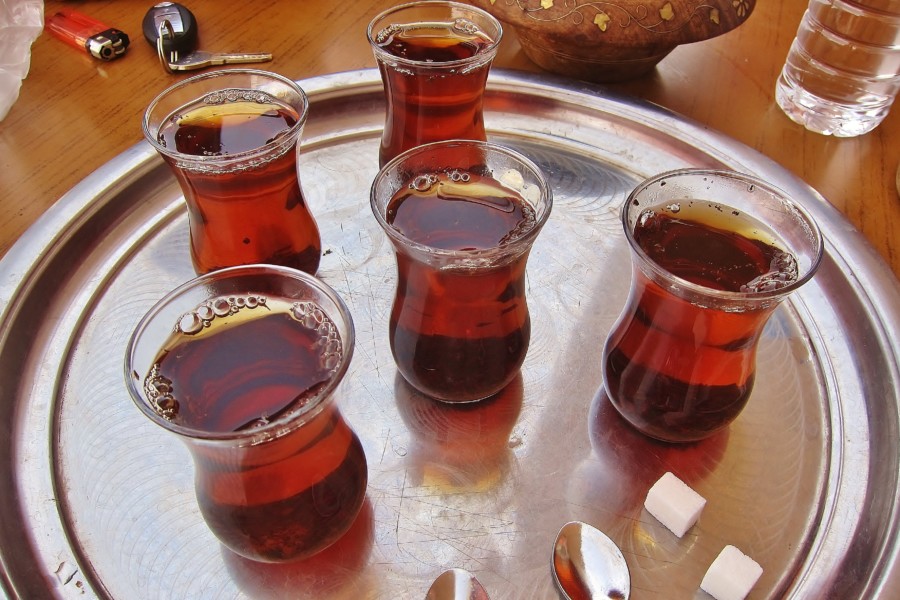
Turkish tea.
According to a research commissioned by UNESCO in 2015, the literacy rate in Turkey stands at 95%, of which men have an advantage over women by 6.6%.
Health
The health system in Turkey consists of a combination of public and private sectors. Turkey has universal health care where all registered residents can receive free medical care in Turkish hospitals. An exception is dental care, which although offered by the public health service, it is not treated seriously and therefore patients must rely on private clinics. Besides, despite the fact that Turkey has undergone major reforms in health care, the care is still better in large cities than in the provinces.
Turkey’s expenditures were lower than in developed countries, although since 2000 it has been getting better. In 2006 there was 1 doctor for every 700 people, 1 nurse for every 580 people and one hospital bed for every 380 people. The rural population is poorly served by a health care system that is much more developed in the western part of the country and therefore many people who live in villages go to doctors in larger cities due to higher standards of treatment. In general, despite a well-developed private sector, the majority of Turks rely on free treatment, while private health insurance accounts for only about 2% of the population. The private sector in Turkey has done a lot of good because it forced the public health service to raise standards and resulted in huge reforms in the years 2000-2010. Still, the main issue is poor funding as health spending in Turkey stood at 6.4% of GDP in 2015, which is why still about 75% of private health care spending comes from patients’ pocket rather than from the insurance.
Culture / Religion
Turks are the people of Central Asia, who come from the present-day Uzbekistan, Kazakhstan and Turkmenistan, although they are mainly from the Altai mountains in western Mongolia. It was a nomadic nation of goat shepherds which from the 6th to the 11th century murdered its way to Anatolia where they finally settled and began murdering the Greeks and Armenians and then other Europeans. In the early stages of the formation of the Turkish nation, which was ruled by various sultans the Turks used Persian-Arabic alphabet and like other Muslims they could have many wives. It was only in 1923 that Kemal Ataturk began to transform his Muslim horde by the image of the European civilization. Since then the Turks have a president and not a sultan, they have a Latin alphabet and not the one which smelled of a goat pasture, and may have only one wife. Kemal Ataturk was a visioner who in my opinion felt the inferiority of the Islamic civilization and the superiority of the White man’s culture. Since then, after the collapse of the multi-ethnic and the multicultural Ottoman Empire, began to shape the culture of the modern Turkey.

Bored shoemaker in Istanbul. Turkey.
Turkish culture is based on Islam, which according to government data accounts for 99% of the population and according to the academic data about 90%. It is also worth mentioning that in recent decades there has been increased support for Sufism, a more fundamental version of Islam which is supported by 20% of the Turkish population. In any case Islam is important in Turkey and in my opinion it will be even more important under the reign of President Erdogan. From the mosques I heard loud prayers 5 times a day and men gather for prayers like soldiers. Social life is also concentrated around the mosques because there are always bazaars and tea rooms nearby. For example, when I was in Istanbul, when I walked around the city and when I was on boat in the Bosphorus I saw a landscape made up of mosques, while from the airport to the city I saw a forest of minarets – and interestingly they build more. Mosque with a high minaret I also in the Van citadel and sometimes I even saw minarets on the roofs of petrol stations. In Turkey there is popular sayings such as “ish Allah” and many women walk with covered heads. I must admit that after traveling around Turkey and observing people I disagree that Turkey is a country of “mild” Islam, if such thing exists at all. Turkish men have European style of clothing and they don’t have Pakistani style beards but naive is the one who can be fooled into their “European” culture. The best proof is that each year during Ramadan in Turkey, Turks slaughter 2.5 million goats and the food in Turkey is 100% halal.
Turks are the people of Central Asia, who come from the present-day Uzbekistan, Kazakhstan and Turkmenistan, although they are mainly from the Altai mountains in western Mongolia. It was a nomadic nation of goat shepherds which from the 6th to the 11th century murdered its way to Anatolia where they finally settled and began murdering the Greeks and Armenians and then other Europeans. In the early stages of the formation of the Turkish nation, which was ruled by various sultans the Turks used Persian-Arabic alphabet and like other Muslims they could have many wives. It was only in 1923 that Kemal Ataturk began to transform his Muslim horde by the image of the European civilization. Since then the Turks have a president and not a sultan, they have a Latin alphabet and not the which smelled of a goat pasture, and may have only one wife. Kemal Ataturk was a visioner who in my opinion felt the inferiority of the Islamic civilization and the superiority of the White man’s culture. Since then, after the collapse of the multi-ethnic and the multicultural Ottoman Empire, began to shape the culture of the modern Turkey.
Turkish culture is based on Islam, which according to government data accounts for 99% of the population and according to the academic data about 90%. It is also worth mentioning that in recent decades there has been increased support for Sufism, a more fundamental version of Islam which is supported by 20% of the Turkish population. In any case Islam is important in Turkey and in my opinion it will be even more important under the reign of President Erdogan. From the mosques I heared loud prayers 5 times a day and men gather for prayers like soldiers. Social life is also concentrated around the mosques because there are always bazaars and tea rooms nearby. For example, when I was in Istanbul, when I walked around the city and when I was on boat in the Bosphorus I saw a landscape made up of mosques, while from the airport to the city I saw a forest of minarets – and interestingly they build more. Mosque with a high minaret I also in the Van citadel and sometimes I even saw minarets on the roofs of petrol stations. In Turkey there is popular sayings such as “ish Allah” and many women walk with covered heads. I must admit that after traveling around Turkey and observing people I disagree that Turkey is a country of “mild” Islam, if such thing exists at all. Turkish men have European style of clothing and they don’t have Pakistani style beards but naive is the one who can be fooled into their “European” culture. The best proof is that each year during Ramadan in Turkey, Turks slaughter 2.5 million goats and the food in Turkey is 100% halal.
I think that when it comes to the Turkish etiquette first I would mention drinking tea and eating kebabs in restaurants, which are always close to the mosque. In such circumstances people first ask about the family and children and then about his work, also to see what kind of portfolio they are dealing with. The thing that I do not like about the Turks is that men kiss each other, what to me stinks with homosexuality. The same habit also exists in the Arab countries. On the other hand men don’t shake hands with women, unless women reach out first. In families there is patriarchy. The man is the leader, the property belongs to him and he disciplines everyone at home. The wife is happy when she gives birth to a son because then she has more recognition in her husband’s eyes. At about the age of 10 boys undergo painful circumcision. Boys are raised to defend their families, defend their sisters and mothers, while daughters are raised to help at home and take care of men at home. As the time goes by, the eldest son helps his father in guarding his sisters and takes over part of his father’s duties. The relationship between mother and daughter is very close but the relationship between father and daughter is just formal. Weddings in Turkey are made by mutual agreement but parents of the young woman are more interested in the groom than the opposite, because of his origin and the property. People are mostly married in their cultural and ethnic background but also in their social (financial) groups, what makes the caste system in Turkey very important. Divorce is possible and it is not a sin in Islam.

Lake in Nemrut Valley. Turkey.
Whilst traveling around Turkey I noticed that I saw women in the streets in a day but after dark I saw only men. Tea houses are the best example of it because they are dominated by men, even during a day. The most popular food is shawarma, many varieties of kebabs, pita bread, yoghurts and vegetables (also grilled) and to drink ajran, Turkish tea and Turkish coffee. For dessert there are sweets similar to those in the Arab countries such as baklava, borek and filo, with honey and walnuts.
Turkey has also its own literature but its art and music referring to the Ottoman times. I think that the most famous elements of the Turkish culture in terms of crafts are lanterns, carpets, silk scarves, clothes and shoes as well as tableware. All these things resemble the patterns on the Sultan’s turban which I saw in the Top Kapi Palace and those which I saw during my travels to Iran or Central Asia. Turks can try to pretend to be more European by adopting certain things but their culture is definitively Muslim and Asian. The most popular sport in Turkey is football, which is played occasionally by about 67% of Turks, although wrestling, judo, archery, basketball, handball and weightlifting are also popular.
Media
Press freedom and freedom of speech in Turkey are a tragic joke. Turkey has now more journalists in jail than China, whose population is 18 times larger. The current tyrant in power Erdogan is known for bringing out loud cases against those who “offended him” and there were around 2000 of those cases and their numbers are dramatically increasing. Behind bars are not only those who wrote articles about him not in accordance with his policies but also students who were throwing arrows to the target with his photo on it. The Internet is fully controlled, all the “bad” and “offensive” websites are regularly removed and social networking sites such as Twitter, WhatsApp and Facebook have been shut down, what stops people from having demonstrations if they want – and they do.

In front of Hosap castle in eastern Turkey.
For a good reason Turkey is called the “prison of silence” and according to the Reporters Without Borders Turkey ranks 155th on the speech and press freedom index. For a comparison, a regime such as the “Democratic” Republic of Congo take 154th place and Iraq where ISIS is going crazy is on the 158th place. I think we now have a good insight into the meaning of the Turkish version of freedom.
Environmental issues
Nature conservation is a subject that the Turkish government does not care about and which it doesn’t want to talk about, and those who care about the nature don’t talk a lot about it because they are afraid to “offend” their tyrant. Turkey has more than 3,000 endemic plants, a lot of natural beauty and animal species but environmental protection is deteriorating rather than improving. The main ecological issues in Turkey are: biodiversity protection, air pollution, water pollution, greenhouse gases and land degradation.
The biggest problem with air pollution is in big cities like Istanbul, Ankara, Bursa and Erzurum. Especially in Istanbul the increased ownership of cars often causes urban smog. Urban air pollutants often caused by transport and less burning of wood and coal are linked to a number of health problems. The level of toxic airborne dust PM10 has reached 36.7 micrograms per cubic meter, much higher than the limit set by the World Health Organization of 20 micrograms. In addition, many indicators of air pollution are not available because there are no restrictions on pollution in Turkey, which result in lung disease. Greenpeace Mediterranean claims that the Afsin-Elbistan coal-fired power plant is the most dangerous power plant and the next one is the Soma coal power plant, also in Turkey.
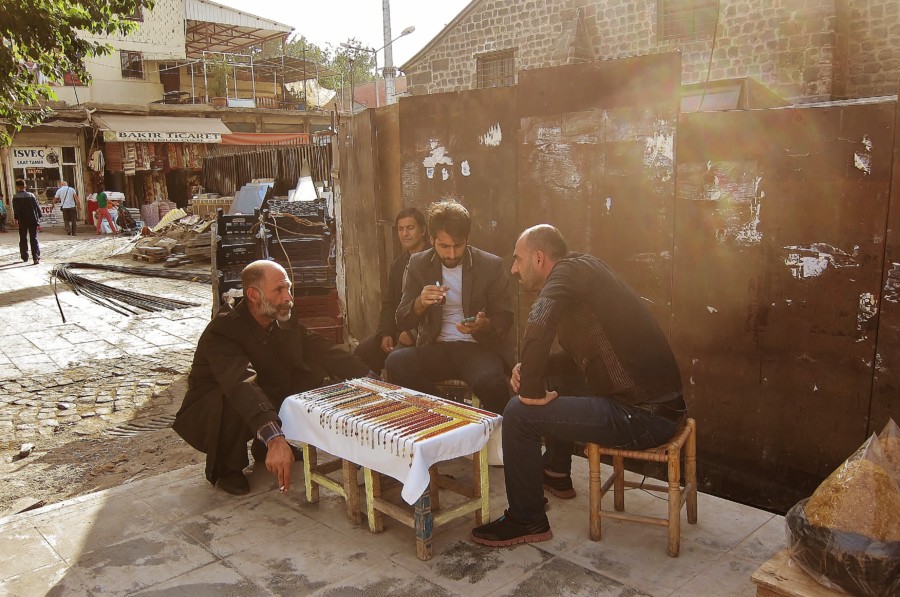
Kurdish men in Diyarbakir. Eastern Turkey.
Turkey has also a problem with the cleanliness of water and I’m talking about the organic pollution of the streams, although there is also a potential leak from the 5,000 oil and gas ships that flow through the Bosporus each year. Another problem is the degradation of land, a critical problem of agriculture caused by inappropriate use of agricultural land, excessive burning or over fertilization. Serious soil erosion occurred in 69% of Turkey’s land area and the situation is so bad that land degradation, desertification and soil contamination are too severe to estimate.
The political attitude of Turkey towards Europe
When it comes to Turkey’s accession to the European Union, in my opinion Turkey has exactly the same right to it as Honduras although I understand that it is nice to be a candidate country for the EU membership. If however the hidden Marxism in Europe proves to be crazy to such a point that Turkey joins the EU, then the European Union would have borders with countries such as Iraq, Iran and Syria, Then Europe would experience mass invasion from all over Turkey and all the surrounding countries, where people are able to pretend that they are Turks.
Despite the fact that Turkey is officially a country of mild Islam in my opinion the Ottoman Turkish nature will never change and that’s why I refer to Turkish politicians as ‘hard-core Islamists in European suits’, who are not yet ready to show their true colours. For centuries Muslim hordes were invading Europe in the search of land, treasures and White sex slaves. Siege of Vienna and the Armenian Genocide are only the two of their numerous crimes against Christians. Even Asia Minor which is currently occupied by Turkey used to be a homeland to Greeks and Armenians.
Today every time there is a dialogue between Turkey and the European countries, Turkey always speaks to Europe using a war rhetoric. Turkey continues to accuse Europe of crimes, despite the fact that it is hard to find a bigger criminal than Turkey. In addition, Turkey blackmails Europe that if it doesn’t do what it wants, then Turkey would invade Europe with millions of Muslim ‘rape-fugees’. Another time Turkey said that the Netherlands couldn’t do anything to Turkey because it has only 48.000 soldiers, while in the Netherlands there are already 400.000 Turks. What it is then if not a war rhetoric?! It is ironic, that every time Europe shows Turkey a middle finger, Turkey starts to preach about ‘democracy‘ and ‘human rights’, what especially in the case of Turkey is the peak of hypocrisy.
The West is worried about Iran, Pakistan, North Korea or Russia, but in my opinion the real threat to Europe is only Turkey, which in the case of invasion would be surely given nuclear weapons from Pakistan, as well as additional soldiers from other Muslim countries. I believe that Turkey would be able to conquer France, because it has not only the military potential, but also an easy way through the Mediterranean Sea. In addition, about 6 million Muslims live in France who at any time are ready to fight for the cause of Allah. These are sleeping wolves waiting for the signal to start an open war against Europe. I am sure that 5 million Muslims living in neighboring Germany would certainly help. In the Benelux countries alone, there are at least an additional 1 million.

Military Propaganda in Turkey.
I talked with the Turks about Turkey’s relationship with Europe, and many have confirmed that Turks as a nation feel aversion to Central Asia because this is where they come from, and they also don’t like Arab countries because they are identified with them. My Turkish neighbours said that: ‘Turks are only able to look towards the West, but unfortunately they are not able to conquer Europe because it is militarily too strong, and that’s why they want to conquer Europe through immigration and by producing a lot of Muslims with European women.’
The Turkish man said that the conquest of Europe and its transformation into a Muslim continent has always been a dream of the Turks and it will never change.” Sometimes I’m afraid that Europe would surrender to Turkey without a fight and the resistance and criticism of Turkey is just a political bluff in order to win right-wing votes by the Left. It is happening now in Europe. In addition Turkey finances construction of mosques in the European countries, which are being built with the applause of very harmful idiots such as liberals and the followers of false progress. On the other hand building churches in Turkey is unthinkable because tolerance has only one side.
The opinion of Turkish politicians about Europe coincides with the opinion of average Turks:
‘It is you who gather there in their parliaments and you still ascend there. It is you who have taken over their positions in their public administration offices. It is you who penetrate the European Parliament. You have become members in their government offices. Yes, keep that way, keep that way, keep it up forever! Our tribe, our siblings, our citizens will take their place in their society as well as in their political life.’
‘Move to better districts, drive the best cars, live in the best homes, breed not three but five children because you are the future of Europe. It will be the best answer to injustice towards you.’
– The President of Turkey and “the wet-dream chancellor” of Germanistan Recep Tayyip Erdogan in his vile monologue on Europe.
The only solution to the Turkish issue is the alliance of the European countries with Russia and then the expulsion of the Turkish hordes behind the Caspian Sea. For this however there is no chance because Europe is currently in the phase of self-destruction. The more I experience the foolishness and rotting Europeans, the more I fear that the words of Erdogan and the Jewish directors of Cultural Enrichment of Europe might come true.
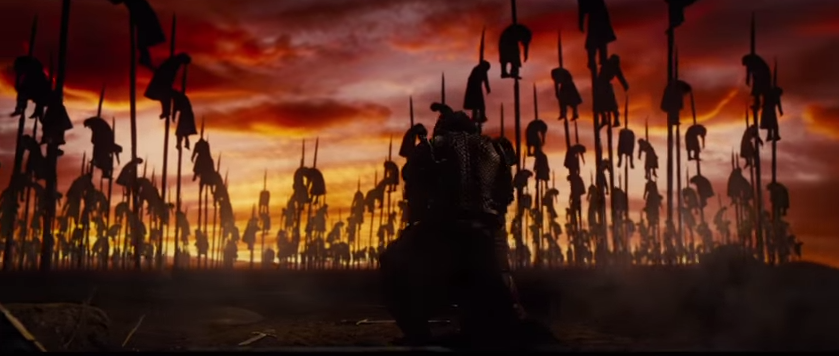
Such Turkish invaders of Europe I like the most. Impaled.
According to many naive Europeans, defending their own country is evil, while Muslims believe that conquering foreign lands in the name of Allah and Prophet Mohammed is part of their culture. In my opinion, the stupidity of Europeans, their own degeneration and indifference to the Great Replacement Project lead to the world conquest of Europe without a fight. This war will not be fought with firearms. It will be bloodless and generational. Turkey is patient, while the politicians who rule Europe are fools and pests.
History of Turkey
Soon………..
Map
Location
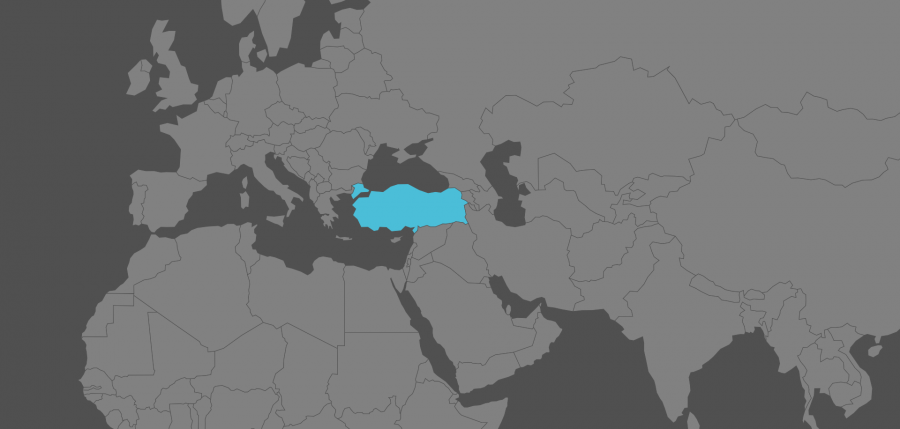
Practical information
Tourist visa: At the airport in Istanbul I got a multiple entry visa which entitled me to a 90-day stay in Turkey in the space of 180 days. I paid £ 20 for my visa although one could also pay €25 or $30 in a visa kiosk before immigration control. The visa can also be obtained at the Turkish consulate in the country of residence but in my opinion it makes no sense if travellers can buy a visa at the airport. In addition, the visa at the consulate is always more expensive and costs too much time. In addition, it is also possible to purchase a Turkish visa online at www.evisa.gov.tr. The advantage of the electronic option is the price which is currently €15 or $20. It has to be paid by card, then the visa must be printed and shown at the border crossing.
When I entered Turkey again, this time from Iraq, I only got a stamp confirming that I crossed the border, next to the visa that I had previously bought in Istanbul. Despite saving $10 I always buy Turkish visa at the airport. It is also worth noting that the prices of Turkish visas are rising. In 2013 the Turkish visa at the airport cost €15 and in 2017 it already cost €25.
Safety: I was in the west and in the east of Turkey, in the land of the Kurds, and I felt safe every time. I travelled in the day and night, I went to big and small towns and to little villages too and people were always curious where I was from but I always felt safe. In every city in Turkey there is a strong presence of armed police force but where there is was no police people always me approached me in a friendly manner. They gave me tea and they wanted to talk.
The danger in Turkey is the plague of scammers in seaside resorts and tourist centres, and also the plague of sex predators who tell fairy tales to women not from this world, at the same time making them dead drunk. On the other hand I’m not sure whether this paragraph even qualifies to dangers because many tourists are naive and so drunk that they invite thieves. As for the European women I think that Turkey is also a home to a lot of White whores whose main goal over there is taking off their pants for Muslims. I had a very honest conversation with a Turkish man, who said without flowery words that: “a Turkish man is like a Black man who would bang everything that is white and has a hole. His first choice would be a white woman but it could be also a white man, a white donkey and even a white chicken”. I think he exaggerated and I can’t take his statement completely seriously, especially that personally I’ve never heard about rapes which wouldn’t be provoked by the European sluts. Sexual harassment is more common than rape.
There is one more issue when it comes to security. The Turkish government tells us that the Kurds living in the east are a terrorist nation that blows up cars and slits throats. I checked this when I travelled the Kurdish lands in Turkey and I assure everyone that it is just a propaganda of hatred flowing from Ankara. It is true that Turkey runs a guerrilla warfare against the Kurds which are interpreted as “terrorist attacks” but tourists are never the targets of these attacks.
Moving around the country: Transport in Turkey is very well organized. In cities there are buses, trams and of course taxis and in big cities like Istanbul, Izmir and Ankara there is metro and overground trains. For example a single metro ride in Istanbul costs 5 lira. There are buses and minibuses operating between cities. For example, for the bus from Sabiha Gokcen Airport in Istanbul to Taksim Square I paid 15 TRY. The bus from Istanbul to Bursa is about 40 TRY for about 2 hours and 154km. In eastern Turkey the bus ride from Batman to Silopi costs 20 TRY for 200 km and about 4 hours drive, including all military checkpoints. There are also small distance journeys which usually cost around 3 to 5 lira. In addition hitchhiking also works well in Turkey and I admit that I crossed a large part of the country that way. On larger distances I recommend traveling by plane. I flew from Istanbul to Van for only £40 one way because I bought a ticket in advance but buying a couple of days before raises the price to £100 or even more. In my experience I know that if someone wants to see lots of places and wants to travel long distances for little money then the best option in Turkey is the plane, provided that we buy in advance. The airlines which I recommend are Turkish Airways, Fly Pegasus and Anadolu Jet. Even a one-way ticket from Diyarbakir to London cost me only £75, what also answers the question about the cost of getting to Turkey.
Prices: (in 2017 when £1 = almost 5 TRY). Let’s not expect prices from Thailand when we travel around Turkey. Unfortunately it is much more expensive, although everyone who works in Poland could definitely afford a Turkish holiday. For example, for a dorm in Istanbul where there were 12 beds in a big room I paid €5 per night, while in other cities like Van or Tatvan for a single room with private bathroom I paid a standard price of 40 lira, which was about €9. In Hasankeyf for a private room I paid 50 lira with breakfast and for a better hotel in Diyarbakir I paid 65 lira a night with breakfast included, although there were also hotels for 25 lira. I guess that someone who travels on a budget but who doesn’t want to sleep in a cave or in a tent must pay around €9- €10 per night as a standard price and with la bit of luck sometimes only €5- €6.
Food in Turkey is cheap and good and it is usually a shawarma with pita bread and a salad and shish kebab of many types. For a kebab in bread I usually paid 5 lira which is only £1. For a better meal in a restaurant composed of kebab but also with rice and a choice of salads I usually paid 12-17 lira or about £3. Turkish tea cost me 1 lira, which was next to nothing and I drank a few of them a day. In Turkey there are also good fruit and bakhlava desserts on which I spent 10 lira a day, sometimes more and sometimes nothing.
There are also transport prices that I discussed in the section “moving around the country”, prices for entries to museums, prices of souvenirs and everyday things such as basic clothing that get worn out faster while on the road. I think that anyone who travels independently, sometimes using a taxi, eating two meals a day and drinking tea all the time, having fruit and desserts must be prepared to spend £20- £30 ($30- $40) a day, depending on whether he travels long distances or not. We should also include separate expenses such as Turkish carpets, although that cost is not mandatory. However, traveling in Turkey can be done much cheaper if one lives in a tent, moves around only by hitchhiking and eats cheapest kebabs. This way of travelling I wouldn’t call a trip when one would enjoy Turkey but rather a survival camp for the very poor.
I want to add that for those who like alcohol, cigarettes and other killers every country will be expensive.
Climate: The climate of Turkey varies considerably from region to region. Coastal areas have milder climates but areas further from the sea are hotter, drier, colder and with lesser rainfall. In Istanbul and in the Marmara Sea the climate is moderate (in winter around 5 ° C and in the summer of 25 ° C); although in winter the temperature may fall below zero. In Western Anatolia (Aegean Region) there is a mild, pleasant Mediterranean climate with temperatures ranging from 9 ° C in winter to 29 ° C in summer. On the south coast of Anatolia (Mediterranean region) the climate is similar. The climate of the Anatolian Plateau (Central Anatolia region) is a steppe climate with a large temperature difference between day and night, with little rainfall and greater snowfall. The average temperature is around 23 ° C in summer and around 2 ° C in winter. The climate in the Black Sea region is wet, warm and humid and the temperatures are in the range from about 23 ° C in summer and around 7 ° C in winter. Eastern and southern Anatolia have long and heavy winters where snow lies from November to the end of April. The average temperature is -13 ° C in winter and about 17 ° C in summer.
I realize that the above paragraph may be difficult to comprehend and that’s why I will discuss it with a more accessible language. From my experience in summer it is most pleasant to go to the sea because there is a humid breeze, even in the hot summer, but as soon as we begin to move inland Europeans accustomed to a colder climate may feel as if they were standing on a frying pan and as if the wind stood still and as if it was grilling them from all sides like a toaster. You will need a hat, sunglasses and a sunscreen, although I also recommend a long sleeved shirt and long trousers made of cotton. Most people visit Turkey in summer and therefore it is very important to prepare accordingly. September in Istanbul was warm and sunny but I wasn’t tired of it as much as few months earlier.



